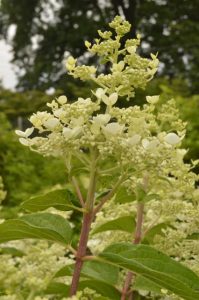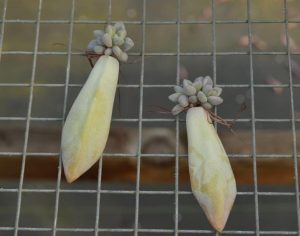Things to do:
- Remove excess leaves and or winter evergreen boughs from early sprouting perennials and bulbs.
- Finish, or perhaps start cutting back ornamental grasses and perennials. Remove the foliage of acaulescent Hellebores (Hellebores that produce flowers from the crown, not the tips of last year’s stems), such as Helleborus x hybridus cultivars or Helleborus atrorubens pictured at right. Try to tend to this as early as possible in the month so the declining foliage does not distract from the flower display or flower buds are accidentally removed.
- Cut and remove shrub or small tree stems that may have been broken during winter storms.
- March is time to finish pruning! Finish removing up to 1/3 of the older stems of Lilacs, Kerria, Forsythia, Slender Deutzia, Weigela and other multi-stemmed flowering shrubs. For Hydrangeas macrophylla, remove a few of the oldest stems, while Hydrangea arborescens cut to near the ground. Hydrangea paniculata cut back more aggressively if they have a more open panicle such as ‘Fire and Ice’ (pictured at right)
 or just receive a light pruning if the flowers are dense with sterile florets. Purple and Golden Smoke Bush should be cut back to 6-12” to provide optimum foliage color, although such treatment will sacrifice summer blooms. Red or Golden Stemmed Dogwoods and Willows should be cut back to 6” or less every 2-3 years to encourage new shoots to develop, which will sport the best red or gold stem color. Have had great success with cutting red stemmed willows (Salix alba ‘Britzensis’) back annually. Vitex (Chaste Tree) can be cut back hard (to 12”) or moderately (3’), depending upon how tall you wish the plant to grow in your Garden – obviously, the less you cut it back, the taller the plant will grow this season.
or just receive a light pruning if the flowers are dense with sterile florets. Purple and Golden Smoke Bush should be cut back to 6-12” to provide optimum foliage color, although such treatment will sacrifice summer blooms. Red or Golden Stemmed Dogwoods and Willows should be cut back to 6” or less every 2-3 years to encourage new shoots to develop, which will sport the best red or gold stem color. Have had great success with cutting red stemmed willows (Salix alba ‘Britzensis’) back annually. Vitex (Chaste Tree) can be cut back hard (to 12”) or moderately (3’), depending upon how tall you wish the plant to grow in your Garden – obviously, the less you cut it back, the taller the plant will grow this season. - Prune Butterfly Bushes back to 12-18” in height, and Russian Sage, Lavender, and Caryopteris back to approximately 6” in height. Do not prune Rosemary plants in spring, but rather wait until summer to shape and/or harvest stems.
- Prune 2-6’ long stems of Forsythia and Pussy Willow to bring inside for forcing. Salix ‘Mount Aso’ is an attractive pink flowered form of Pussy Willow, bred for the cut flower industry (pictured at left).
- Prune shrub roses back by about ½. For hybrid Tea Roses, cut plants back by ½, making certain that you cut to an outside facing bud (those small red dots, typically subtended by a leaf scar are leaf buds).
- Thatch lawns and overseed bare or thin areas. It is best to thatch the lawn when it is dry, allowing at least several days to pass after a rain before attempting to thatch.
- If Crabgrass was an issue in 2020, apply pre-emergent on lawns for Crabgrass control before Forsythia shows any flower color.
- Take soil samples from turf and vegetable garden areas to determine pH and soil fertility requirements. They should be submitted via a mailer that is available at the local extension office. Try not to walk on soil if it is wet or saturated, since it will compact, reducing the air spaces and destroing the soil structure.
- Edge bedlines and lightly remulch bed areas. If the beds were mulched last year, only 1-2” of new mulch should be needed unless there was significant erosion or the mulch was removed with the autumn leaves! Remember, shredded leaves make a great mulch!
- Seed out peas and radishes at the end of the month. The old rule of thumb was to sow the seed on St. Patrick’s Day, which may be too early and cold in northern NJ, unless you have very sandy and well-drained soils.
- Start Broccoli seeds indoors in early March, tomato seeds from mid-March on and eggplant, peppers and parsley towards the end of March.
- Remove your Canna, Colocasia and Alocasia tubers from their winter storage boxes, pot them up in an adequately sized container, and place in a sunny window. They will sprout best if bottom heat is provided. Water sufficiently to keep the soil moist but not wet until you start to see signs of life.
- Bring Brugmansia and Edible Figs out of the dark basement, start to water regularly and place in a warm sunny window.
- Any Plumaria (common name of Frangipani) that was stored in the basement should also be potted up and brought into an area with bright light.
- If you have a straggly Coleus plant (reclassified as Plectranthus scutellarioides a few years back and now once again Coleus scutellarioides!), you may wish to take cuttings and start new, stronger plants to move outdoors for summer display.
- Succulents that have been kept indoors should be repotted in spring if they have roots wrapping around the root ball when removed from the container. Or, if the roots have literally lifted the plant and the soil up to the lip of the pot and all the water runs over the rim when watered. Shake off some of the previous soil, prune off any decaying roots and repot in a container that is 2”+/- larger in diameter. Use a well-drained potting media, since succulents resent most soils.
- Groom your succulents as well, removing any brown and desiccated foliage. If the plant has become too leggy, as often happens after several months of low intensity light, you can cut off the upper portion of the plant that has foliage, let the wound callus over by laying it on a table for 3-5 days and then stick the rosette back into a container with well-drained soil. The stem will typically regenerate new roots and a new plant!
- Remove any tired or half-brown foliage from your houseplants and provide a 2-4 month granular feed or a ½ dilute liquid feed every month through September starting in March. As the day lengths get longer, the plants will start to grow and the extra feed will be appreciated.
- Many succulents can also be propagated by simply laying a leaf on top of the soil or even on a bench top (Echeveria leaves are pictured at right). A new plantlet and roots will typically appear at the base of the leaf within several weeks!



Bruce Crawford
Program Leader in Home and Public Horticulture (NJAES)



